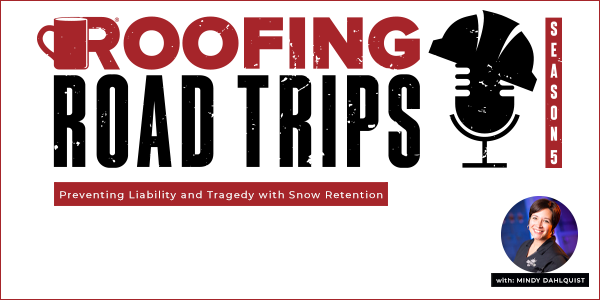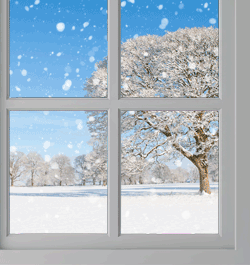Mindy Dahlquist and Nick Metzer - Preventing Liability and Tragedy with Snow Retention - PODCAST TRANSCRIPTION
September 8, 2023 at 5:30 p.m.Editor's note: The following is the transcript of a live interview with Nick Metzer from The Roofing Company and Mindy Dahlquist from TRA Snow and Sun. You can read the interview below or listen to the podcast.
Intro & Outro Voiceover: Welcome to Roofing Road Trips with Heidi. Explore the roofing industry through the eyes of a long-term professional within the trade. Listen for insights, interviews, and exciting news in the roofing industry today.
Heidi J. Ellsworth: Hello and welcome to another Roofing Road Trips from Roofers Coffee Shop. This is Heidi Ellsworth, and we're talking about snow retention today. After this last winter, I can't think of a better topic. It is so important. All across the country, it doesn't matter where you're at, even California, so much snow. So, we got ahold of our friends at TRA Snow and Sun to talk about snow retention and also our friend Nick Mentzer, who is a roofing contractor, who is dealing with this all the time. He is with The Roofing Company. Welcome to the show, Mindy and Nick.
Nick Mentzer: Hey, I appreciate it. Thank you. Nice to meet you, Heidi.
Mindy Dahlquist: I am glad to be here and I am glad to bring on one of our customers so we can get some knowledgeable information out there.
Heidi J. Ellsworth: Love this, love the topic. It's so relevant right now. So, before we dive into it, let's start with some introductions. So, I'm Nick, if you could introduce yourself and tell us a little bit about you and your company.
Nick Mentzer: Sure. So, my name is Nick Mentzer. I work for The Roofing Company out of Granby, Colorado, up in the Rocky Mountains here. And I've been with Jeff Johnston for over 10 years now, and originally cut my teeth in the contracting field in Nebraska. I was an excavator and made it up this direction and haven't really looked back since. So, I specialize more in the steep slope roofing in the pitched applications rather than the low slope. And so, snow retention is a part of my everyday life and something that needs to be considered on the job.
Heidi J. Ellsworth: Yeah. You live in a beautiful part of the country, so pretty and a lot of snow.
Nick Mentzer: I tell people I live in a Coast Guard.
Heidi J. Ellsworth: Mindy, can you please introduce yourself and tell us about TRA?
Mindy Dahlquist: Absolutely. My name is Mindy Dahlquist and I live in Utah, where TRA Snow and Sun is located. We're right out of American Fork, so we try to avoid some of the snow ourselves a little bit in just this little valley that we're in. But I come from a place of ice, unfortunately. So, I am from the Midwest out of Ohio originally, and I made my way out here about four years ago. And I have just really enjoyed all of the aspects of working for TRA Snow and Sun. They've been a great company to work for. And from our customer standpoint, I think we're a pretty reasonable company to purchase from and work with that way, as well.
Heidi J. Ellsworth: Yeah, you are definitely leaders for a long time and bringing something that really...
Nick Mentzer: They've got the best customer service in the industry. I can tell you that.
Heidi J. Ellsworth: I love it. That's great.
Nick Mentzer: Without a doubt.
Heidi J. Ellsworth: Well, okay. Let's start with some of that. I love... Because TRA has really led the industry and as Nick said, customer service, number one. But let's look at what causes ice and snow to fall dangerously from roofs taking out people and property. Nick, can you kind of give us that big overview?
Nick Mentzer: Sure. As the winter progresses and the snow accumulates the altering weather patterns, they produce a layering effect on the roof. And when you have lack of friction forming on the roof and those freeze thaw cycles that start to introduce different elements into the layering, eventually something's going to slide. And a lot of people, you can visualize an avalanche on a mountain. It's the same thing's happening on it.
Heidi J. Ellsworth: Yeah. Go ahead, Mindy.
Mindy Dahlquist: I think the most important thing that a lot of people don't realize too is when that snow accumulates on the roof, it's going to be there whether you want it to be or not. So, whether you're utilizing snow retention or not, that snow does accumulate and becomes one large glacial mass on the roof. And so when that slide does occur, you're not talking just one or two inches of snow. It is a mound of snow that wastes thousands of pounds depending on what area you're in. But it is very, very dangerous. And a lot of times, that heat loss starts up at the ridge of the roof, and that can also cause a lot of ice damming problems and a lot of other concerns if it's not taken care of very early on.
Heidi J. Ellsworth: Yeah. Well, how many times I've seen it? We live up in the mountains, Oregon, so just like Colorado or Utah, we see it all the time and you just have these huge piles, mounds of snow around the structure, around the building that sometimes won't melt until midsummer. And what does that do? Obviously, loss of life, people walking underneath it, animals, pets is the worst, but if you really look also at what it does to your plants and your landscaping, it's not pretty. So, okay.
Nick Mentzer: Property damage, too.
Heidi J. Ellsworth: Yeah.
Nick Mentzer: A lot of property damage.
Heidi J. Ellsworth: Talk about that for just a minute, Nick, because it grabs and takes everything off the roof.
Nick Mentzer: Yeah. So when that slide goes, it doesn't care what's holding it. It wants to get to the ground. So, one of the systems that we've used in the past that we use very prevalently on standing seam roofs, the hidden fastener roofs is a clamp on system. And you do that because the last thing you want to do is put a hole in your roof with a fastener at that point straight through the sheet metal. So, we clamp onto the ribs, and if you've just got a basic snow retention system that is just meeting your local building code and that snow wants to go, it'll pick that up and it'll tear it right off that rip, and it'll have a tear in your panel. It could take out a deck down below. It could introduce water into your underlayment, your ice and water, depending on how the tear does, the sheet metal doesn't care what it cuts. So, it's just very alarming how things can really snowball if you don't mind that.
Heidi J. Ellsworth: Yeah. And I've seen full gutter systems taken out. Yeah.
Mindy Dahlquist: Oh, sure.
Heidi J. Ellsworth: It's definitely crazy. So Mindy, let's talk about snow retention. Can you talk about that overall, what it means to incorporate snow retention into your roofing projects?
Mindy Dahlquist: Absolutely. So, snow retention is really just a phrase or a group of words that basically says that we are holding the snow on the roof. We're retaining that snow on the roof, allowing it to freeze into place. So, a lot of times people think that the fences, brackets, snow stops, snow guards, whatever you want to call them, are up there to kind of cut that snow up into pieces and let it slide down in little chunks, and that is not the overall goal of snow retention. So, we want that snow to freeze into place. When utilizing brackets, you're going to have that frozen into one giant blanketed mass across the entirety of the roof, where the fences, they are made to take a little bit more of that impact of sliding snow and ice. And then it is still meant to freeze into place.
But just like Nick said, if that's not an engineered system and you just throw up one row of snow fence in an area that gets a large amount of snow, that snow fence isn't going to stop anything. It's not going to freeze to that snow pack. It's just going to be a little rider going down on a snow sled right off the roof along with it. So, snow retention is something that is, I think, very important for the roofing industry, but if it's done incorrectly, it can lead to damage. So, it needs to make sure that you're working with a snow retention manufacturer that knows their products, their strengths, that way you are able to put up a system that is safe and reliable, as well.
Heidi J. Ellsworth: Makes total sense. So Nick, can you kind of talk about what you see, on all the beautiful homes that you do in your part of Colorado, can you talk a little bit about snow retention and how important it is for you and your business?
Nick Mentzer: Yeah. First and foremost, we want to protect life safety. And that's the reason why a lot of local building codes will implement the need for snow retention, especially on metal roofs, where on shingle roofs, you'll have the granules that help hold stuff in place. But it's incredible. Not only can we inform the customer, we want to form these relationships going forward and inform customer is somebody that we can set ourselves apart with our competition. We can show them that we care about their roof, their property, their family, and just to begin the discussion, we can talk about the areas that they'd like to protect, whether it's going to be a deck, whether it's going to be a walkway, whether it's going to be right outside the garage, they don't want the snow falling on the guests that are parked there in the driveway.
Heidi J. Ellsworth: Exactly.
Nick Mentzer: So, yeah. It's a nice process that you can learn from the contractors in your local area.
Heidi J. Ellsworth: Yeah. And so, do you have any examples of some of the snow retention installations you've done this last year and just kind of, what's the demand look like? What are you seeing?
Nick Mentzer: Oh, of course. So, there's different types of snow retention. So, you're going to have the structural elements, some of the architects and engineers incorporate that into their designs and their new construction. And then you're going to have some retro applications if people have had some slides in the past, where you can go in after the fact and put in. Like with TRA, you can put in a bracket H and you can put that onto your shingle roofs and just help reinforce some problematic areas that they've seen slides in the past. And then you'll just have your regular homeowners that have a re-roof. It doesn't involve any commercial construction, no architects, and we're just going in there and taking a look at an existing roof and redoing that. And if we want to get TRA involved, where they can provide an engineered system that they can either evaluate and decide to select or turn down in that, also protects us as a contractor, where we've presented them an option and they've decided to go a different direction.
Heidi J. Ellsworth: That makes... And you're seeing the growth. You're seeing growth in people really understanding that they need snow retention.
Nick Mentzer: True. And this was an epic winter, this past winter, too. So, people have seen slides where they haven't seen slides in the past, and it's really started the discussion and it's been very exciting this year, especially with the oncoming winner here now. We're three weeks away from fall colors.
Heidi J. Ellsworth: Oh, my gosh. Don't say that.
Nick Mentzer: Well, I can't believe that.
Heidi J. Ellsworth: I know. Wow. Well, Mindy, you talk to contractors all over, you're hearing it all day. So, what are some of the stories that really illustrate the need for snow retention that you've heard?
Mindy Dahlquist: So, this is something that I have to say I go into with a very heavy heart. So I'm going to get pretty serious for a minute. Our company has joined in with many court cases that included deaths, unfortunately. I've personally watched some of these videos of body cam videos from police officers, who arrive at the scene after this has occurred before the people have been fully taken an ambulance, anything like that. And let me just say, it's not something that anybody needs to watch. It's not something I plan on sharing anytime soon, but it is devastating. And unfortunately, I can give you quite a few examples. I'll leave all the details out so I'm able to respect the families in these situations. But there was, in 2023, there was actually two that I'm very familiar with. A 50-year-old man in Brighton, Utah, and a five-year-old girl in Durango, Colorado.
And then 2020, there was a 73-year-old woman in Vermont that snow and ice slid off her roof and hit her in the head. 2019, a 25-year-old man in Crested Butte, Colorado. In 2018, a 50-year-old woman and her eight-year-old son in Kirkwood, California, and then in Idaho in 2016, a two-year-old girl in Island Park, Idaho. So, those are just some examples and some of the details that are just gruesome. Unfortunately, when these things happen, it's not a quick in and out kind of. It's not a way to die that anybody should have to go through. So, I think it is something that's very serious. It gives me a lot of passion about the snow on the roof and making sure that even if you're not utilizing snow retention, that you're being smart about where you're shedding snow and all of the different factors that you can use. And unfortunately, in a lot of these situations, things like a sign go up on the side of the building that says, "Hey, watch out for snow. It might fall on your head." Those types of things, that doesn't remove any kind of liability.
So, if you know there's a problem, find a solution for it. Don't just put a sign up and hope that somebody's going to be able to read that after a snowstorm.
Heidi J. Ellsworth: Yeah, I think that just totally illustrates how important snow retention is, and people don't realize how critical that can be and to follow code or go beyond the building codes. Nick, you kind of talked about that. It's not just about the code because sometimes, the code's not enough.
Nick Mentzer: Right, and you'll have architects just throw a row of snow fence knowing that there's a walkway down below. But that's just a notation on a drawing at that point. I think we really need to look at each case individually, the way the building's oriented, the way the snow load in the area may affect that structure. It's a very dynamic process.
Mindy Dahlquist: And currently, and Nick, I would love to pick your brain after this conversation some other time about some of the codes in your area, because most of the areas that I travel to, there are no known codes on snow retention.
Nick Mentzer: Oh, really.
Mindy Dahlquist: So, even in Lake Tahoe, California, in places that receive very, very large amounts of snow, they're now mandated for solar panels and for other things on their roof that can honestly just make that problem worse. And so, finding a way to work with the local municipalities to help enforce these codes and also help create them since we're a company that tests our products and has the information on the strength values of our specific products and brackets and fences. If we're able to work with other companies, when we've been working with ASTM to help get standards out there for this, as well. But it's such a process, and if you don't have buy-in from the municipalities, you're basically just spinning your wheels.
Heidi J. Ellsworth: Right. But when they hear those kinds of statistics that you put out there, they're going to have to be listening.
Nick Mentzer: It's pay now or pay later. And unfortunately, that's the reality of the situation. Lawyers aren't cheap, accidents aren't cheap, and we care about the general public and our friends and family.
Heidi J. Ellsworth: So, really when we're talking about protecting homeowners and the contractors, Nick, because you are liable. That all comes back around and I know you're passionate about it, but it's really important for the contractors listening out there to really be pushing or I mean, what are some of the tips to the contractors out there who are in snow zones?
Nick Mentzer: Oh, I can provide plenty of tips here. And one of the things that we do is a standard on our proposals is to note that any snow retention that is on the drawings, like this is per plans, because we want to bid apples to apples with our competition. We don't want to scare anybody with big numbers. And then we'll go in and itemize a recommended system. But in our proposal, we'll say, "This is not engineered. This is per architect specs and snow maintenance is still recommended." Engineered systems are available upon request, and I like to get that engineered system. I like to have the commercial owners and the general contractors be aware that it is out there and let them turn it down. And then we've got that piece of paper in the world that we live in. It's so valuable nowadays, where you've offered something, they turned it down, and you've done your best to inform the customer.
Mindy Dahlquist: Yup. Always doing your due diligence and then if everyone wants to walk away from it, that's nothing more that you could have done.
Heidi J. Ellsworth: Yeah, that's so smart. So Mindy, as contractors are looking at all these different snow systems and there are different ones out there, what's your advice for how to decide which Snow Retention System works best?
Mindy Dahlquist: So, there are... Honestly, I think the biggest difference is going to be what type of application you're looking for. So, the specific roofing material is probably the first question that I would go to on that, because if you're looking at synthetic slate or shakes, if you're looking at asphalt shingles, which snow unfortunately does move on that. It's just going to be a little different. So there's always going to be a different system specific to that roofing material. And you don't just want to put up, I mean, there are plastic brackets out there. You can give more money to our friends at Amazon, but unfortunately, that is not something that I recommend in the plastic world. It ends up being a landscape ornament. It just does not stay on the roof. We have great competitors out there to our product, so I don't have anything much to say there.
They all have standup products. It's just really going to come down to what you're looking for with your snow retention manufacturer, what kind of roofing material you have, what kind of application you're looking for, and then how much information you need from them, as well. As Nick mentioned, we do offer engineered systems. We stand behind those systems, and we're also pretty good at just making sure we're taking care of the customer, as well. Even if it's not an engineered system, how can we fix this? How can we make this better? All of my visits that I do out of state, I'm always asking, "Is there anything else we need to change? Is there..." I mean, we're all involved in R & D and all of those changes that do occur down the road. So, if there's any of our customers that ever have recommendations or issues with installation, definitely let us know because we can't fix things that we're not aware of, and I think every other company feels the same way.
Heidi J. Ellsworth: Yeah. Nick, you started out talking about the TRA customer service and the products, and then you talked about the engineering systems. Talk to us a little bit about how important that is for your business.
Nick Mentzer: So, when we do a lot of commercial application, we do a lot of the big resorts here in Colorado specifically. We just got done doing the new resort on top Breckenridge and I went through... That actually has an engineered snow retention system on top of it at the moment. It did not on the initial drawings and TRA worked with me through the entire process. They joined phone calls with me with the general contractor. They've talked to the owner team. We've talked to the engineers together. It's been incredible, the amount that they vested in an opportunity to provide an engineered snow retention system. They didn't even know they were going to get it, and we did, but it was just something where you can see that they've gone the extra mile for me and I've continually gave them my business because I know that they've got my back.
Heidi J. Ellsworth: Yeah. And as you're looking at your roofs going from residential to these beautiful, huge commercial properties, and when you're looking at the different types of snow retention, what are some of your recommendations for determining what type to use?
Nick Mentzer: Sure. Well, obviously, you want to look at the product that you're going to be installing, and a lot of times there's a few different selections that you can go from there. There's different aesthetics you can take a look at. There's some really interesting artistic options. There's a lot of different finishes. There's handfuls and handfuls and handfuls of powder coating options. If you're going with steel or aluminum, you can go with a Core 10. There's copper options. Hell, they've got some snow clips that look like a bear or something like that.
Heidi J. Ellsworth: I see those. I love them.
Nick Mentzer: So really, the options are pretty endless and you can go through that with your customers, and we've got a nice little showroom here up in Granby too, that people can touch it, smell it, taste it. That's kind of what I say.
Heidi J. Ellsworth: Tasted [inaudible 00:21:11]. I always have loved the Starburst snow guards, too. I think they're pretty.
Nick Mentzer: Oh, there you go.
See, I'm really partial to the Apexes. If there's not one identified in the proposal, I always go with the Apex. I like those better than the classics. I think they're stronger, and I think aesthetically, they [inaudible 00:21:32] it on the roof, if I'm not mistaken.
Mindy Dahlquist: I agree, and any of our sales team would agree with that, as well. Everyone likes the Apex better and they are definitely the strongest out there.
Heidi J. Ellsworth: That's excellent. Okay. Nick, when is the best time to install Snow Guards? I know at the end of the job, but is there a time of year? Are you doing it year round? How does that work?
Mindy Dahlquist: Right now. Right, Nick?
Nick Mentzer: Sure.
Heidi J. Ellsworth: Right now.
Nick Mentzer: Right now. We do it year round. But if I can make a recommendation, you begin the talks early, especially if somebody owns a home and they understand what they've seen in the past, if you're doing a re-roof. Now, if you have the ability to get the architects and the engineers and the owners involved in commercial applications, early is better there, too. But if I can lace in the snow retention into the shingles, that's just going to be preferred because I can cover the fasteners where they're fastened in and that benefits me and that benefits the owner. And you can always do retro applications, but if you have the opportunity, do it early.
Heidi J. Ellsworth: Smart. Okay. So Mindy, tell everyone out there, they want to get involved, they've listened to this, they know they need to start selling snow retention. How do they get in touch with you? How do they get started?
Mindy Dahlquist: So, sales@trasnowandsun.com is probably the easiest way to reach any of our sales team. We are a pretty small, big company, so we will either talk to Heather, Coy, Devin, or Ben. There is not much in between that, and they'll make sure you're taken care of. If you have any questions, we're actually building a media book that we would be able to send out to contractors specifically. So, just get in contact with me. Again, Mindy Dahlquist is my name, and I can either physically bring you one of these in person or send one to you, and those will have some of our YouTube videos and some of our manufacturing information on there, so that you're able to stand there with a homeowner or with whoever's going to be in-charge, a general contractor, anybody, an architect, and just be able to answer some of those questions on why you think it's necessary without you having to do a lot of that research on your own. So, I think those will be a very beneficial tool for some guys to have in their tool belt, and girls, of course.
Heidi J. Ellsworth: Yeah.
Nick Mentzer: And the website's very easy to navigate, too. If you understand what your product is, what you're looking for, and if you need to inform your contractor, if you're a homeowner, and this is an opportunity. The website's very user-friendly.
Heidi J. Ellsworth: Well, and they can also find you on Roofers Coffee Shop and Metal Coffee Shop in the directory. And so, that will get you directly to TRA and to all these fine folks that Mindy was talking about. Mindy, Nick, thank you so much for being on here. What a great information on really life-changing information.
Mindy Dahlquist: Absolutely.
Nick Mentzer: Sure.
Mindy Dahlquist: No problem. Thank you, Heidi.
Heidi J. Ellsworth: Thank you.
Nick Mentzer: Yeah, thank you.
Heidi J. Ellsworth: Thank you so much, and thank you all for listening. More information to help grow your business, protect your business. We will keep this coming, but right now, go check out TRA on the directories, on Roofers Coffee Shop, and Metal Coffee Shop. Find out what they're doing, read the case studies, see all the beautiful, strong performance-oriented snow retention that's out there. It could save you, your company, and your customers. Be sure to also check out all of the podcasts, which are under the RLW navigation, under Roofing Road Trips, or on your favorite podcast channel. Be sure to subscribe and set those notifications, so you don't miss a single episode. And we will be seeing you next time on Roofing Road Trips.
Intro & Outro Voiceover: Make sure to subscribe to our channel and leave a review. Thanks for listening. This has been Roofing Road Trips with Heidi from the Roofers Coffee Shop.























Comments
Leave a Reply
Have an account? Login to leave a comment!
Sign In